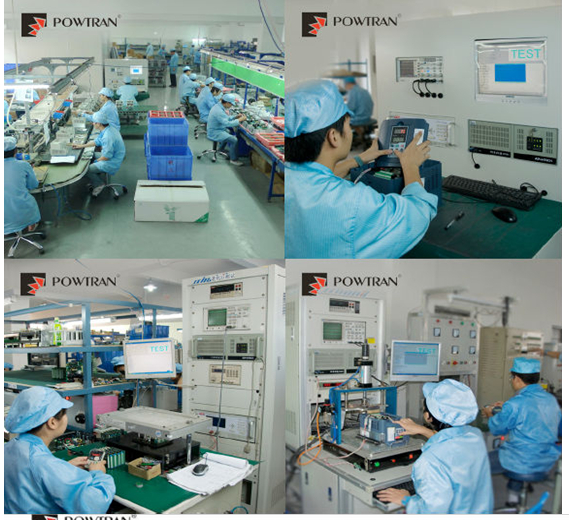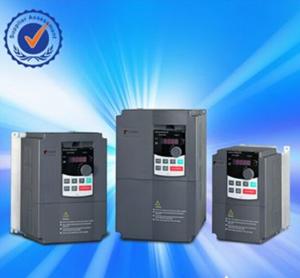Off Grid MPPT Solar Inverter, Solar Pump Inverter 380v 2.2kw 4kw 5.5kw
- Loading Port:
- Shanghai
- Payment Terms:
- TT or LC
- Min Order Qty:
- 150000 watt
- Supply Capability:
- 3000000 watt/month
OKorder Service Pledge
OKorder Financial Service
You Might Also Like
1. Structure of Off Grid MPPT Solar Inverter, Solar Pump Inverter 380v 2.2kw 4kw 5.5kw Description
A solar inverter, or PV inverter, or Solar converter, converts the variable direct current (DC) output of a photovoltaic (PV) solar panel into a
utility frequency alternating current (AC) that can be fed into a commercial electrical grid or used by a local, off-grid electrical network. It is
a critical BOS–component in a photovoltaic system, allowing the use of ordinary AC-powered equipment. Solar inverters have special
functions adapted for use with photovoltaic arrays, including maximum power point tracking and anti-islanding protection.
2. Main Features of the Off Grid MPPT Solar Inverter, Solar Pump Inverter 380v 2.2kw 4kw 5.5kw
﹒ Supports AC&DC input:
DC solar panel input. And If no good sunshine, can use grid AC regular input work the pumps.
﹒Dry protection :
If no water in the ground, the water pump will stop working automaticly and when the water comes, starts to working automaticly.
﹒Automatic working:
When the sunshine not good then pumps slow down automatically and when sun become good then go on working.
﹒Save cost/directly connect solar panel:
Solar panle connects solar inverter directly and to the pump. Also can control the water level in the tank. No enough water in the tank
working fast, enough water will stop working automaticly. (how many water you need, you can set the parameters)
﹒Speed & frequency control, No need battery:
3. Off Grid MPPT Solar Inverter, Solar Pump Inverter 380v 2.2kw 4kw 5.5kw Images

4. Off Grid MPPT Solar Inverter, Solar Pump Inverter 380v 2.2kw 4kw 5.5kw Specification
Inverter Model | Input voltage | Rated output power (kW) | Rated output current (A) |
PI9100-S 0R4G1 | Single phase AC 220V ± 10%;
DC 220-380V | 0.4 | 2.5 |
PI9100-S 0R7G1 | 0.75 | 4 | |
PI9100-S 1R5G1 | 1.5 | 7 | |
PI9100-S 2R2G1 | 2.2 | 10 | |
PI9100-S 004G1 | 4.0 | 16 | |
PI9200-S 5R5G1 | 5.5 | 25 | |
PI9100-S 0R4G2 | 3 phase AC 220V ± 10%;
DC 220-380V | 0.4 | 2.5 |
PI9100-S 0R7G2 | 0.75 | 4 | |
PI9100-S 1R5G2 | 1.5 | 7 | |
PI9100-S 2R2G2 | 2.2 | 10 | |
PI9100-S 004G2 | 4.0 | 16 | |
PI9200-S 5R5G2 | 5.5 | 25 | |
PI9200-S 7R5G2 | 7.5 | 32 | |
PI9200-S 011G2 | 11 | 45 | |
PI9200-S 015G2 | 15.0 | 60 | |
PI9100-S 0R7G3 | 3 phase AC 380V ± 10%;
DC 350-750V | 0.75 | 2.5 |
PI9100-S 1R5G3 | 1.5 | 3.8 | |
PI9100-S 2R2G3 | 2.2 | 5.1 | |
PI9100-S 004G3 | 4.0 | 9 | |
PI9100-S 5R5G3 | 5.5 | 13 | |
PI9100-S 7R5G3 | 7.5 | 17 | |
PI9230-S 011G3 | 11 | 25 | |
PI9230-S 015G3 | 15 | 32 |
5. FAQ of Off Grid MPPT Solar Inverter, Solar Pump Inverter 380v 2.2kw 4kw 5.5kw
Q1. What is the difference between inverter and solar inverter?
A1. Inverter only has AC inpput, but solar inverter both connect to AC input and solar panel, it saves more power.
Q2. What is the difference between MPPT&PWM?
A2. MPPT has higher efficiency, it can track the max power point and won't waste energy.
Q3. What is the waranty of product?
A3. 12 months.
- Q:What is the role of voltage support in a solar inverter?
- The role of voltage support in a solar inverter is to regulate and stabilize the voltage levels within the solar power system. It ensures that the voltage output from the solar panels matches the voltage requirements of the connected devices or the grid. By maintaining a consistent voltage, it helps to prevent overvoltage or undervoltage situations, which could damage the equipment or disrupt the power supply. Voltage support also helps to enhance the overall efficiency and reliability of the solar power system.
- Q:What is the function of a solar inverter in a solar power system?
- The function of a solar inverter in a solar power system is to convert the direct current (DC) electricity generated by the solar panels into alternating current (AC) electricity that can be used to power household appliances and feed into the electrical grid.
- Q:What is the purpose of a solar inverter in a solar power system?
- The purpose of a solar inverter in a solar power system is to convert the direct current (DC) electricity generated by the solar panels into alternating current (AC) electricity that can be used to power household appliances or be fed back into the grid.
- Q:What is the role of a reactive power controller in a solar inverter?
- The role of a reactive power controller in a solar inverter is to regulate and maintain the power factor of the inverter output. It ensures that the reactive power generated by the solar panels is properly balanced with the active power, thereby optimizing the efficiency and stability of the solar power system.
- Q:How does a solar inverter handle voltage regulation in the grid?
- A solar inverter handles voltage regulation in the grid by constantly monitoring the voltage levels and adjusting its output accordingly. If the grid voltage is too high, the inverter reduces its output to prevent overloading and potential damage to connected devices. Conversely, if the grid voltage is too low, the inverter increases its output to compensate for the deficit and maintain a stable voltage supply. This regulation ensures that the solar energy generated by the inverter is seamlessly integrated into the grid while adhering to grid voltage standards.
- Q:How does a solar inverter handle voltage dips and swells?
- A solar inverter is designed to handle voltage dips and swells by constantly monitoring the grid voltage. When a dip or swell occurs, the inverter's control system adjusts the output voltage accordingly to maintain a stable output. This is done through the use of power electronics and control algorithms that regulate the voltage and frequency of the inverter's output.
- Q:What is the role of a DC-DC converter in a solar inverter?
- The role of a DC-DC converter in a solar inverter is to convert the direct current (DC) generated by the solar panels into the appropriate voltage level required for the inverter to convert it into alternating current (AC) electricity. This conversion ensures efficient power transfer from the solar panels to the grid or for use in residential or commercial applications.
- Q:Can a solar inverter be used with solar-powered outdoor lighting?
- Yes, a solar inverter can be used with solar-powered outdoor lighting. A solar inverter is responsible for converting the DC (direct current) electricity produced by solar panels into AC (alternating current) electricity that can be used to power various devices, including outdoor lighting systems. This allows the solar-powered outdoor lighting to function efficiently and effectively.
- Q:Can a solar inverter be used with different types of mounting systems?
- Yes, a solar inverter can be used with different types of mounting systems. The solar inverter is responsible for converting the direct current (DC) generated by the solar panels into alternating current (AC) that can be used to power electrical devices. It is compatible with various mounting systems such as rooftop, ground-mounted, or pole-mounted installations, as long as the solar panels are properly connected to the inverter.
- Q:How does shade affect the performance of a solar inverter?
- Shade negatively impacts the performance of a solar inverter as it reduces the amount of sunlight reaching the solar panels, thereby reducing the amount of electricity generated. Inverters are designed to operate optimally under full sunlight, and when shaded, their efficiency decreases, leading to a decrease in overall energy production. Additionally, shade can cause hotspots on panels, potentially damaging the system and reducing its lifespan. To ensure maximum performance, it is important to minimize shade and ensure unobstructed sunlight for solar inverters.
1. Manufacturer Overview |
|
|---|---|
| Location | |
| Year Established | |
| Annual Output Value | |
| Main Markets | |
| Company Certifications | |
2. Manufacturer Certificates |
|
|---|---|
| a) Certification Name | |
| Range | |
| Reference | |
| Validity Period | |
3. Manufacturer Capability |
|
|---|---|
| a)Trade Capacity | |
| Nearest Port | |
| Export Percentage | |
| No.of Employees in Trade Department | |
| Language Spoken: | |
| b)Factory Information | |
| Factory Size: | |
| No. of Production Lines | |
| Contract Manufacturing | |
| Product Price Range | |
Send your message to us
Off Grid MPPT Solar Inverter, Solar Pump Inverter 380v 2.2kw 4kw 5.5kw
- Loading Port:
- Shanghai
- Payment Terms:
- TT or LC
- Min Order Qty:
- 150000 watt
- Supply Capability:
- 3000000 watt/month
OKorder Service Pledge
OKorder Financial Service
Similar products
New products
Hot products
Hot Searches
Related keywords
































